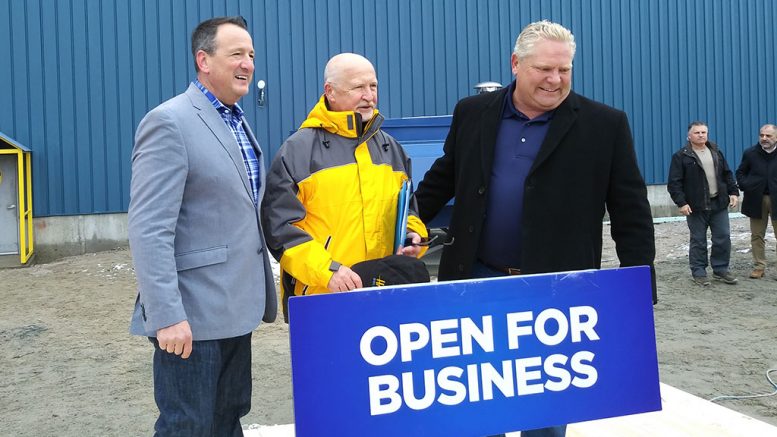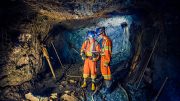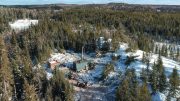Ontario’s long-standing mining legacy, availability of geological data and established track record with mineral explorers, developers and producers, position it as a world-class destination for the industry. Below, we provide an overview of eight companies with assets in the province.
Argonaut Gold

An aerial view of Argonaut Gold’s Magino gold propery in Ontario, located 14 km southeast of Dubreuilville. Credit: Argonaut Gold.
Argonaut Gold (TSX: AR) is a gold and silver producer, with operations in Nevada and Mexico and pre-production assets in Ontario and Mexico.
In March, the company announced an all-share acquisition of Alio Gold, which added the Florida Canyon heap leach mine to its portfolio.
This year, Argonaut expects its operations to generate 210,000-230,000 oz. gold-equivalent at all-in sustaining costs (AISCs) of US$1,225-1,350 per ounce.
The company’s heap leach El Castillo complex in Durango state includes the El Castillo and San Agustin mines. This year, the site is expected to deliver a total of 107,000-118,000 oz. gold-equivalent.
Also in Mexico, Argonaut’s La Colorada open pit operation in Sonora state is forecast to churn out a further 53,000-55,000 oz. gold-equivalent in 2020.
The newly acquired Florida Canyon heap leach operation is anticipated to generate an additional 50,000-57,000 oz. gold-equivalent this year. The Alio Gold merger closed July 1.
Florida Canyon has been operating since 1986. Located 72 km southwest of Winnemucca, the site covers over 118 sq. km and, according to the company, presents additional potential for transitional and sulphide mineralization.
In the pre-development stage, Argonaut’s Magino project in Ontario, 40 km northeast of Wawa, includes a past-producing underground mine, which generated 803,135 tonnes at 4.43 grams gold per tonne. This site is adjacent to Alamos Gold’s (TSX, NYSE: AGI) Island Gold mine.
A 2017 feasibility study for Magino suggests a 10,000 tonne-per-day open pit operation, with a 15-year life. The mine would generate an average of 115,700 oz. gold annually, at AISCs of US$711 per ounce. With a pre-production capital cost estimate of US$293 million, the after-tax net present value estimate for the project is US$288 million, at a 5% discount rate. Magino reserves total 59 million tonnes, grading 1.13 grams gold, and contain 2.1 million oz. gold.
In July, Argonaut reported high-grade intercepts from areas below the proposed Magino pit. Highlights include 6 metres of 8.31 grams gold; 1 metre of 48.5 grams gold; and 2 metres of 25.88 grams gold.
Also in July, the company closed a $126.5-million bought deal financing. Proceeds are intended for advancing the Magino project, as well as for general corporate purposes.
Argonaut also holds the Cerro del Gallo and Ana Paula projects in Mexico’s Guanajuato and Guerrero states.
The company has an $848-million market capitalization.
Generation Mining
Generation Mining (TSX: GENM) is developing the 220-sq.-km Marathon PGM-copper project in northwestern Ontario, 8 km north of the town of Marathon.
In July 2019, Generation Mining closed its acquisition of a 51% initial interest in the Marathon property from Sibanye-Stillwater (JSE: SSW). The company also entered into a joint-venture agreement with the South Africa-headquartered miner, which allows it to increase its interest in the project to 80% by spending $10 million and completing a preliminary economic assessment (PEA) within four years.
Under the terms of the agreement, Sibanye may then reacquire a 31% stake in the project, bringing its total to 51%, by paying 31% of the capital cost to the joint venture upon a production decision. If it chooses to increase this interest, the producer would then pay 51% of the remaining capital, with Generation Mining effectively responsible for 34% of the initial project cost.
In September, the company released an updated pit-constrained resource estimate for the Marathon deposit, based on a $25 per tonne net smelter return cutoff, with 179.2 million measured and indicated tonnes, at 1.24 grams per tonne palladium-equivalent (with contained palladium, platinum, copper, gold and silver), for a total of 7.1 million palladium-equivalent ounces. Additional inferred resources stand at 668,000 tonnes, grading 0.95 gram palladium-equivalent, for a further 21,000 oz. palladium-equivalent. Mineral resources are also contained within the smaller Geordie and Sally deposits at the property.
A preliminary economic estimate (PEA) completed in January of this year, based on the measured and indicated Marathon deposit resource, outlines a 14-year open pit operation, producing an average of 194,000 oz. palladium-equivalent annually at AISCs of US$586 per oz. palladium, net of by-product credits. With a pre-production capital cost estimate of $431 million, the after-tax net present value estimate for the development comes in at $871 million, at a 5% discount rate.
This operation would ultimately produce a PGM-containing copper concentrate, expected to be very low in deleterious elements, that would be shipped off-site.
In July, Generation Mining announced that it had contracted engineering companies for a feasibility study on the Marathon project. The study is expected to be completed by early 2021. At the end of August, the company also released increased palladium, platinum and copper recovery projections, based on metallurgical test work. These include palladium recoveries of 86.9%, platinum recoveries of 84.2% and copper recoveries of 93%.
Generation Mining has a $58-million market capitalization.
Harte Gold

Harte Gold’s Sugar Zone gold mine in northern Ontario. Credit: Harte Gold.
Harte Gold (TSX: HRT) holds the 793-sq.-km Sugar zone property, 80 km east of the Hemlo gold camp, which hosts the Sugar zone underground mine.
Following a four-month shut down earlier this year due to the Covid-19 pandemic, the Sugar zone mine started back up at the end of July and the mill was restarted on Aug. 5. This year, the operation is expected to produce 20,000-24,000 oz. gold, increasing to 60,000-65,000 oz. by 2021.
Sugar zone achieved commercial production in September 2019. Last year, the mine generated 27,316 oz. gold.
Next year’s production growth is expected to come from higher-grade areas as well as from increased mining rates and higher development advance rates. Next year, Harte plans to use paste backfill at Sugar to improve efficiencies and increase operating flexibility.
In addition, the company is evaluating a mill expansion to 1,200 tonnes per day by 2022, up from the current 800 tonnes per day capacity, with a feasibility study expected in the fourth quarter. Harte is transitioning to owner-operator from contract mining services at the site. The transition is also expected to be complete by year-end.
Probable reserves across the Sugar, Middle and Wolf zones total 3.9 million tonnes grading 7.1 grams gold per tonne, containing a total of 890,000 oz. gold.
In early July, the company entered into a binding term sheet with Appian Capital for up to US$30 million in financing to restart the Sugar zone mine. The financing package includes an US$18.5-million non-revolving credit facility, a US$9.5-million private placement and the grant of a 0.5% net smelter return (NSR) royalty, in exchange for a further US$2 million. The proceeds are expected to fund the start-up of the mine, while also providing a pathway towards expansion and an increase in exploration.
Appian currently holds 24.4% of the company’s shares; Orion Resource Finance has a 5.1% stake.
Harte Gold has a $159.6-million market capitalization.
HighGold Mining
HighGold Mining (TSXV: HIGH) holds the Johnson Tract project in south-central Alaska, as well as the Munro-Croesus property in Ontario, 75 km east of Timmins.
Johnson Tract covers 85 sq. km, is 16 km from a port and features a high-grade polymetallic deposit, with indicated mineral resources of 2.1 million tonnes, grading 6.07 grams gold, 5.8 grams silver, 0.57% copper, 0.8% lead and 5.85% zinc (10.93 grams gold-equivalent), containing 750,000 oz. gold-equivalent. Inferred resources add 581,000 tonnes at 2.05 grams gold, 8.7 grams silver, 0.54% copper, 0.33% lead and 6.67% zinc (7.16 grams gold-equivalent), containing 134,000 oz. gold-equivalent.
Anaconda Minerals first discovered Johnson Tract in 1982. Between 1982 and 1995, 88 drill holes were completed at the site, and metallurgical testing suggests good gold and base metal recoveries to marketable concentrates, which would be low in deleterious elements. HighGold acquired Johnson Tract in 2019.
According to the company, the Johnson Tract deposit is continuous and steeply dipping with thick and high-grade mineralization well suited for bulk underground mining methods and includes a high-grade core of 1.25 million tonnes at 14.5 grams gold-equivalent.
There are five exploration targets nearby the existing resource, distributed over 12 km of strike. These include the Northeast Offset zone, interpreted as an extension of the deposit, as well as the North trend, a 1-km long undrilled alteration zone. This year, HighGold plans to drill at least 15,000 metres at Johnson Tract.
In Ontario’s Timmins gold camp, HighGold holds 200 sq. km of ground. Its holdings include the Munro-Croesus property, which features the historic Croesus mine, known for its bonanza-grade gold output. Munro-Croesus lies 3 km northwest of Pan American Silver’s (TSX: PAAS; NASDAQ: PAAS) Fenn-Gib gold deposit.
HighGold acquired the project in 2019, as part of Constantine Metals Resources’ (TSXV: CEM) gold asset spinout. In May, HighGold released drill results from Munro-Croesus, reporting a highlight intercept of 0.3 metre of 29.1 grams gold from a vein 80 metres southeast of the historic shaft and 30 metres down-dip of historic high-grade intersections. Additional assays are pending.
This year, the company plans to drill at least 5,000 metres across its Timmins-area holdings. Half of this program was completed prior to a Covid-19 related suspension in March.
At the end of July, the company closed a $13.8-million bought deal. Proceeds are intended for exploration and corporate use.
HighGold Mining has an $85.9-million market capitalization.
MacDonald Mines
MacDonald Mines’ (TSXV: BMK) key asset is the high-grade, 183-sq.-km SPJ project in Ontario, 40 km northeast of Sudbury.
The SPJ project includes the Scadding, Powerline, Java, Blueberry, Loney and Golden-Copper properties and is prospective for high-grade gold mineralization, in addition to copper, nickel, silver, cobalt and rare earth elements (REEs).
According to MacDonald, the Scadding portion of SPJ features an unusual style of gold mineralization for a Canadian setting, where alteration zones preferentially host polymetallic mineralization. The Geological Survey of Canada has recently suggested that SPJ lies within a potential iron-oxide-copper-gold (IOCG) district. Exploration results to date from the company’s program around the Scadding mineralization suggest that this zone is likely a gold-rich IOGC formation.
A geophysical survey completed over Scadding has outlined folds, which appear to control the placement and geometry of the gold-bearing zones. Fold hinges appear to preferentially host gold.
The historic Scadding mine produced 127,000 tonnes between 1984 and 1990, at a head grade of 7.2 grams gold, from three shallow open pits and an underground decline. A 46-hole drill program started last fall. Drill highlights from the North Pit area include 12 metres of 52 grams gold; 19 metres of 59.2 grams gold; and 5 metres of 4.4 grams gold.
Drill results from SPJ reported in June and July showed high-grade mineralization along trend of a past-producing pit and intersected a new, broad gold-bearing zone, which also returned copper, nickel, cobalt and rare earth elements assays.
Beyond Scadding, channel and grab samples from the areas within the SPJ property returned anomalous copper, nickel, silver and cobalt assays, in addition to gold.
This year’s 14,000-metre exploration program is aimed at further defining the Scadding mineralization and includes a series of holes targeting folds and hinge zones. Additional work on the ground, as well as geophysics and drilling is scheduled for regional targets.
In early August, the company closed a $4.2-million non-brokered private placement.
Macdonald Mines has a $25.3-million market capitalization.
Makara Mining
Makara Mining (CSE: MAKA; FSE: MK0) is focused on advancing the Rude Creek and Kenora gold projects in west-central Yukon and northwestern Ontario, respectively.
The 41.6-sq.-km Rude Creek property lies within the Dawson Range gold district, 160 km south of Dawson City. Makara’s mineral deposit model for the project is based on an orogenic gold system.
In August, the company started a 2,000-metre reverse circulation (RC) drill program at Rude Creek, to focus on a 1,000-metre by 1,600-metre gold-in-soil anomaly. Recent tight-spaced soil sampling completed over the 150-metre by 300-metre Northeast prospect returned up to 1.17 grams gold per tonne.
Makara may earn up to 70% in Rude Creek. In May, the company signed an option agreement to earn the stake by paying $125,000 and issuing 3.8 million of its shares to the vendor as well as spending $3.2 million on exploration over the next three years.
Rude Creek is 12 km southeast of Western Copper and Gold’s (TSX: WRN) Casino deposit. Newmont’s (TSX: NGT; NYSE: NEM) Coffee deposit is also 45 km northwest of the property.
In Ontario, Makara holds the 8 sq. km Kenora project, 209 km east of Winnipeg. Gold mineralization was first discovered at this site in the late nineteenth century. Exploration activity in the area picked up in 1984. The Canadian Pacific railway, as well as natural gas and hydro transmission lines, cross the property.
In the summer of 1994, Canstar Resources (TSXV: ROX) completed a reconnaissance mapping and sampling program at the site, with 25 of the 108 samples returning high-grade gold in or around shear zones. A subsequent prospecting campaign in 2015 revealed new gold showings, including a 68 grams gold sample from a mineralized shear zone. Additional prospecting and trenching completed between 2015 and 2017 returned channel intervals that include 18 metres of 2 grams gold and 29 metres of 3.1 grams gold.
In August, Makara also optioned the Idaho Creek property in the Yukon, adjacent to Rude Creek, from Atac Resources (TSXV: ATC). Makara may earn a 100% interest in the project by making total cash payments of $150,000 and issuing 750,000 shares to Atac by July 1, 2024, and spending $2 million on exploration at the site by Dec. 1, 2024. A one-time milestone payment of $1 per oz. gold-equivalent would be due to the vendor if a mineral resource is defined on the property.
Makara Mining has a $32.5-million market capitalization.
Pure Gold Mining

Pure Gold Mining VP of exploration Phil Smerchanski near a portal during test mining at the Madsen gold project in Ontario. Credit: Pure Gold MIning.
Pure Gold Mining (TSXV: PGM; LSE: PUR) is working towards a first gold pour from the past-producing Pure Gold Red Lake mine by year-end.
The 47-sq.-km site hosts a 7-km long prospective trend and two historic mines: the Madsen Red Lake and Starratt-Olsen mines, which together generated approximately 2.6 million oz. gold. Based on past operations, the Pure Gold site features a mill, tailings facility, a 1,275-metre shaft and 27 levels of underground workings as well as a ramp, along with grid power and highway access.
In February 2019, the company released the results of a feasibility study on an 800-tonne-per-day development at the site, which suggests a 12-year, high-grade underground mine producing up to 125,000 oz. payable gold annually. Based on a pre-production total capital cost of $95.1 million and life-of-mine AISCs of US$787 per oz., the after-tax net present value estimate is $247 million, at a 5% discount rate, with a 36% internal rate of return.
By August, Pure Gold decided to go ahead with the development and secured a US$90-million financing with Sprott Resource Lending, made up of a US$65-million loan and a US$25-million callable gold stream.
In June of this year, the company also closed a $15-million non-brokered flow-through financing, which is intended for additional exploration drilling across the PureGold property. Also in June, Pure Gold started a 30,000-metre underground and surface diamond drill program, aimed at near-term mine plan optimization and resource growth, while also targeting new discoveries.
In July, Pure Gold reported high-grade results from the site. Highlights include 10 metres of 12.8 grams gold per tonne; 2 metres of 9.3 grams gold; and 2 metres of 10.6 grams gold.
Probable reserves at Pure Gold total 3.5 million tonnes, grading 9 grams gold per tonne, for a total of 1 million ounces. The reserves are within indicated resources of 7.2 million tonnes at 8.9 grams gold, with an additional inferred resource of 1.9 million tonnes, grading 7.7 grams gold. While the entirety of the reserve is within the Madsen deposit, resources include contributions from the Fork, Russet South and Wedge zones.
In August, AngloGold Ashanti (JSE: ANG) exercised 5 million share purchase warrants, investing an additional $5 million into Pure Gold, which brought its stake in the developer to 16%. AngloGold remains the company’s largest shareholder.
Pure Gold Mining has a $773.7-million market capitalization.
Wesdome Gold Mines

The Kiena mine site in Val D’Or, Quebec. Credit: Wesdome Gold Mines.
Wesdome Gold Mines (TSX: WDO) holds the Eagle River operation in Ontario, 50 km east of Wawa, as well as the past-producing Kiena complex in Quebec, within the Val-d’Or town limits.
This year, the company expects to generate 90,000-100,000 oz. gold at AISCs of US$985-1,040 per oz., which is unchanged from its January guidance. The majority of production is expected to come from the Eagle River underground mine, with a contribution from the Mishi pit. The underground and open pit feed a central 850-tonne-per-day mill at Eagle River.
In recent months, underground drilling at the Eagle River mine has traced the Falcon zone, from surface, over 1,000 metres down plunge. The area is interpreted as the up-plunge extension of the 7-zone that is in production and the extensions are nearby existing infrastructure. Drill highlights released in July from the Falcon and 7 zones include 5 metres of 49.9 grams gold per tonne; 6 metres of 314.4 grams gold; and 2 metres of 68.4 grams gold.
Proven and probable reserves across the 110-sq.-km complex total 1.2 million tonnes, at 14.4 grams gold, containing 550,000 ounces. This year, Wesdome expects to drill 85,000 metres underground at Eagle River, with a further 33,500 metres budgeted towards surface exploration.
In Quebec, the 70.5-sq.-km Kiena complex has been on care and maintenance since 2013 and contains a permitted, 2,000 tonne per day mill, a 930-metre shaft, and a ramp system that extends down to 1,050 metres.
In May, Wesdome released the results of a preliminary economic assessment on a restart of Kiena. The study outlined an eight-year operation, producing an average of 85,931 oz. gold annually at AISCs of US$512 per ounce. With an initial capital cost estimate of $35 million, the after-tax net present value estimate of the development is $416 million, at a 5% discount rate.
Wesdome expects to drill 80,000 metres at Kiena ahead of a resource estimate in the fourth quarter, which would be followed by a prefeasibility study. A production restart decision is expected next year.
Wesdome Gold Mines has a $1.9-billion market capitalization.





Be the first to comment on "Ontario snapshot: Eight companies to watch"